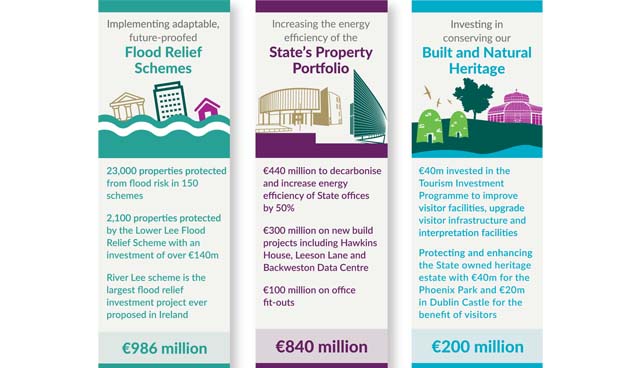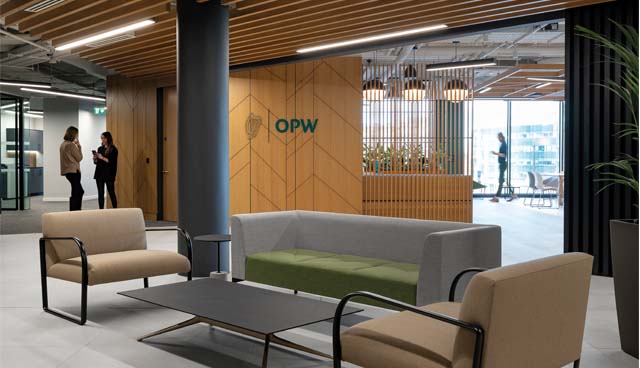
Achieving sustainable infrastructure through asset management
6th May 2022
Net zero carbon: An unfortunate ‘compromise’
6th May 2022The Office of Public Works (OPW) has one of the largest and most diverse property portfolios in the State, including over 2,000 buildings that range from some of the most recognisable properties in the country, such as Dublin Castle or Leinster House, to Garda stations and government offices. The OPW also has a lead role in managing flood risk and providing project management expertise to a number of client departments and agencies.
The breadth of the organisation’s responsibilities is reflected in the number, nature and scale of the projects that fall to it to deliver under the National Development Plan (NDP) covering the period 2021-2030.
When the NDP was published last autumn, Minister of State with responsibility for the Office of Public Works Patrick O’Donovan TD noted that the OPW would be managing projects and programmes to the value of €4 billion through its own vote and on an agency basis on behalf of clients. The Minister also highlighted the OPW’s evolving role as a leader in the transition to a sustainable, low-carbon, resource-efficient economy. He noted that a key objective for the OPW, in delivering important public infrastructure under the NDP, was to “advance sustainable solutions that mitigate against the effects of climate change”.
The investment of some €4 billion represents a doubling in value of the existing level of capital investments within the remit of the OPW. This will present a significant challenge to the organisation’s capacity and Minister O’Donovan explained that, as well as actively engaging with the Department of Public Expenditure and Reform on resourcing project delivery under the NDP, the organisation has also taken a number of important initiatives to “gear-up” for this challenge. Within the overall framework of the Civil Service Renewal Programme (CSR 2030), the OPW has streamlined its organisational structures, improved its project governance arrangements, invested in upskilling its workforce and embraced a number of ICT initiatives to improve organisational productivity.
As a result, the Minister has expressed his full confidence that the OPW is well-positioned to deliver on its commitments under the NDP, in a manner that is fully aligned with the Government’s policies on climate action and sustainability. In this context, the overall purpose of the €1 billion investment earmarked for the Flood Risk Management area involves works to protect communities across Ireland from the impacts of climate change through future-proofed, adaptable flood risk management schemes.
The OPW will be investing a further €1.4 billion in State properties that will support key climate action targets by increasing the energy efficiency of the State’s office accommodation portfolio. Office accommodation investment will also involve the creation of more agile, digitally enabled, and predominantly open plan working environments. They will incorporate more collaborative spaces and significantly reduce the use of cellular offices so as to facilitate the evolving operational requirements of government departments.
This investment includes works to heritage sites nationwide to protect and promote the State’s built and archaeological heritage through sensitive conservation, refurbishment and animation for the enjoyment of current and future generations.
The balance of around €1.6 billion will involve the OPW in managing a wide range of projects for client departments and agencies. Investment will include works to major cultural institutions, a large infrastructure project at Rosslare Europort, and a new Forensic Science Laboratory in the Backweston Campus in County Kildare. Under the Garda Capital Programme a significant number of projects will be delivered, including the Military Road complex in Dublin. Investment in some heritage sites will be co-funded by the Department of Tourism, Culture, Arts, Gaeltacht, Sports and Media, through Fáilte Ireland.
Flood risk management schemes (€1 billion)
Communities threatened from river and coastal flood risk will see investment in some 150 flood relief schemes progressed over the lifetime of the NDP, protecting approximately 23,000 properties.
All flood relief schemes are designed to be adaptable to the impacts of climate change scenarios, including identifying locations in the scheme’s contributing catchment where there may be opportunities to implement Natural Water Retention Measures. These can comprise a broad range of multi-functioning measures that use natural processes and features to reduce flood risk, improve water quality and create habitats.
The largest flood relief investment project ever proposed in Ireland is the Lower Lee Flood Relief Scheme, representing over €140 million of investment for Cork City. It will protect 2,100 properties from tidal and fluvial flooding.
Investment in the OPW Estate (€1.4 billion)
The investment will:
- address EU and Government climate change obligations to significantly reduce the estate’s carbon footprint through investment in new builds (€300 million), Property Obsolescence Programme, covering building fabric, energy and systems upgrades (€440 million);
- fit-out of accommodation (€100 million);
- meet a range of complementary objectives within the Heritage Estate (€200 million) for the conservation and presentation of historic buildings and sites, including collaboration with Fáilte Ireland for co-funding of particular projects under the Tourism Investment Programme;
- meet obligations under the Convention Centre Dublin Public Private Partnership Agreement (€250 million); and
- facilitate property acquisitions and disbursement of grants (€80 million).
The OPW will oversee the construction of major new energy efficient office developments on the site of the old Hawkins House, on Leeson Lane and a shared Government Data Centre at the Backweston Campus in County Kildare. The shared Government Data Centre will be fitted with connections that will allow it to be powered by renewable energy from a potential future solar farm on site, and will facilitate the decommissioning of existing facilities that are much less energy efficient and are no longer fit for purpose.

A flagship project under the Energy Retrofit Programme is the refurbishment of Tom Johnson House in Dublin, which was constructed in the 1970s. The works undertaken will extend the useful life of the building and transform it into an exemplary, energy-efficient headquarters for the Department of the Environment, Climate and Communications. A 75 per cent reduction of annual energy use will be achieved and most of the cost of around €50 million will be met from the EU’s National Recovery and Resilience Fund (NRRP).
Investment in the Heritage Estate will enable the OPW to commence the implementation of Master Plans for the Phoenix Park and Dublin Castle to meet the twin objectives of improving accessibility to, and enhancing the visitor experience at both locations. Some of the key infrastructural works to improve accessibility to the park include creating new and upgrading existing cycling and walking routes and road improvement works.
Restoration and upgrade works at the Magazine Fort and Phoenix Park Visitor Centre will also be undertaken to further improve the visitor experience at the park.
Investment in Dublin Castle will build on the recent redevelopment of the medieval Record Tower and the planned refurbishment of the visitor reception. Some of the key elements of the Masterplan for Dublin Castle will include:
- a new interpretation space, in the East Cross-Block, will tell the story of the building during the revolutionary period, from 1916 to 1922;
- upgrading the public realm, particularly the Lower Castle Yard to enhance the accessibility of the site to all visitors; and
- a new museum space will tell the 800-year history of Dublin Castle through objects in the OPW’s collection, archaeological finds from the site and long-term loans from other national cultural institutions.
T: (046) 942 2000
E: info@opw.ie
W: www.gov.ie/opw






 Ossian Smyth TD
Ossian Smyth TD Florika Fink-Hooijer
Florika Fink-Hooijer Antoine Oger
Antoine Oger Laura Curtis-Moss
Laura Curtis-Moss Anthony Costello
Anthony Costello Anja Murray
Anja Murray Niall Ó Donnchú
Niall Ó Donnchú Mike Savage
Mike Savage Brian Carroll
Brian Carroll Claire Downey
Claire Downey Oisín Coghlan
Oisín Coghlan Stephen Onakuse
Stephen Onakuse Kevin O’Sullivan
Kevin O’Sullivan Susan Hegarty
Susan Hegarty Hendrik W van der Kamp
Hendrik W van der Kamp Philip Nugent
Philip Nugent Adrian Smyth
Adrian Smyth  Ainhoa Gonzalez Del Campo
Ainhoa Gonzalez Del Campo  Geoff Dooley
Geoff Dooley  Clare Pillman
Clare Pillman  David Greenfield
David Greenfield Danielle Conaghan
Danielle Conaghan Peter McEvoy
Peter McEvoy Triona McGrath
Triona McGrath J Owen Lewis
J Owen Lewis Gavin Smith
Gavin Smith Imelda Hurley
Imelda Hurley Lucy Gaffney
Lucy Gaffney Dr Venkatesh Kannan
Dr Venkatesh Kannan Kevin Hegarty
Kevin Hegarty Eimear Cotter
Eimear Cotter Aditya Arora
Aditya Arora Patric Child
Patric Child Eleanor Roche
Eleanor Roche Andy Bleasdale
Andy Bleasdale Andrew Muir MLA
Andrew Muir MLA Chris Hewitt
Chris Hewitt Francesca Racioppi
Francesca Racioppi Christopher Hammond
Christopher Hammond Laura Díaz Anadón
Laura Díaz Anadón Lorna McAdoo
Lorna McAdoo Conor Murphy
Conor Murphy  Mark Horton
Mark Horton  Niall McLoughlin
Niall McLoughlin  Zoe Kavanagh
Zoe Kavanagh Niall Ó Donnchú
Niall Ó Donnchú Venkatesh Kannan
Venkatesh Kannan David McGee
David McGee Anna Rose
Anna Rose Paul Hogan
Paul Hogan








